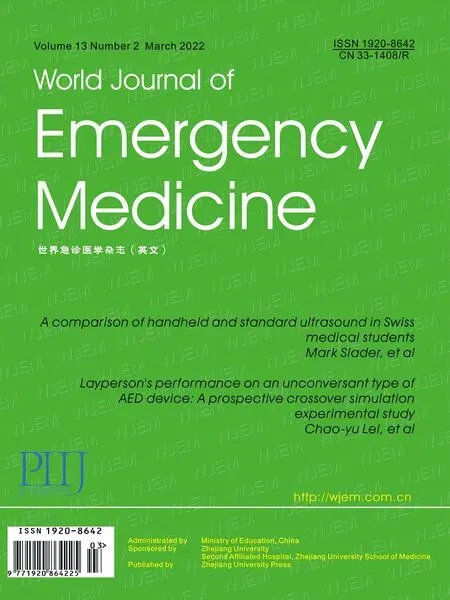Comment on “Comparison of different versions of the quick sequential organ failure assessment for predicting in-hospital mortality of sepsis patients”
Hang Dai, Ping Wang, Ji-mei Zhang, Li Luo
Department of Emergency Medicine, the Third People’s Hospital of Chengdu, Chengdu 610031, China
Dear editor,
We have read with great interest the recent article“Comparison of different versions of the quick sequential organ failure assessment for predicting in-hospital mortality of sepsis patients: A retrospective observational study”.They showed that the performance of the procalcitonin-enhanced qSOFA (PqSOFA) was similar to that of the qSOFA, and the lactate-enhanced qSOFA (LqSOFA) and the modified qSOFA(MqSOFA) were superior to the qSOFA for predicting inhospital mortality. Further, they suggested that the MqSOFA should be a candidate for the qSOFA in the emergency department (ED). We congratulate the authors for their contributions. However, we has several concerns about this research.
Firstly, several revised versions of the qSOFA by including additional parameters to increase its performance have been proposed. In this study, the authors included PqSOFA, LqSOFA, and MqSOFA; however, they did not include other revised qSOFA, such as VqSOFA (qSOFA score + initial venous lactate level),and mod-qSOFA(qSOFA score + one point for age > 50 years old).In addition, whether serum lactate concentrations in the study were examined using venous or arterial blood is not clear.Therefore, detailed information might be suppled.
Secondly, the primary outcomes of the four qSOFA versions in original studies were different. The primary outcome of PqSOFA in the study by Xia et alwas 28-day sepsis mortality, while the primary outcomes of other studies were in-hospital mortality. Hence, we doubted about the authors’ outcome definition as death or survival at discharge for all four versions of the qSOFA. Thus,we propose the time-dependent area under the receiver operating characteristic curve (TimeROC) to evaluate the effectiveness of these revised qSOFA .
Finally, the study aimed to validate and compare the performance of the four qSOFA in predicting sepsis mortality.In general, the level of validity depends on the assessment of discrimination (the area under the ROC curve) and calibration (e.g.,Brier score, calibration plot, Hosmer-Lemeshow test), as well as clinical usefulness evaluated by decision curves.Meanwhile, the net reclassification and integrated discrimination could be used as candidates for assessing the added value of new-in parameters in these revised qSOFA. Unfortunately, only ROC curve analyses were conducted in this study.
We thank the authors for their important work. Further study might be required to develop more acute, inexpensive,and risk-free tools with superior performance concerning discrimination and calibration in predicting sepsis mortality in the ED.
None.
Not needed.
None.
All the authors drafted the manuscript, and contributed substantially to its revision.
 World Journal of Emergency Medicine2022年2期
World Journal of Emergency Medicine2022年2期
- World Journal of Emergency Medicine的其它文章
- An incident of chloroform poisoning on a university campus
- A comparison of handheld and standard ultrasound in Swiss medical students
- Artificial intelligence computed tomography helps evaluate the severity of COVID-19 patients: A retrospective study
- Layperson’s performance on an unconversant type of AED device: A prospective crossover simulation experimental study
- The expression of oxidative stress genes related to myocardial ischemia reperfusion injury in patients with ST-elevation myocardial infarction
- Comparison of different versions of the quick sequential organ failure assessment for predicting inhospital mortality of sepsis patients: A retrospective observational study
